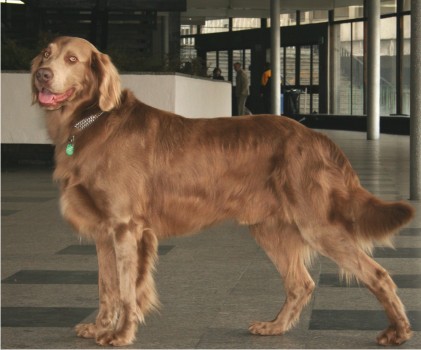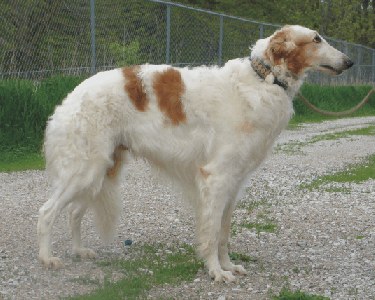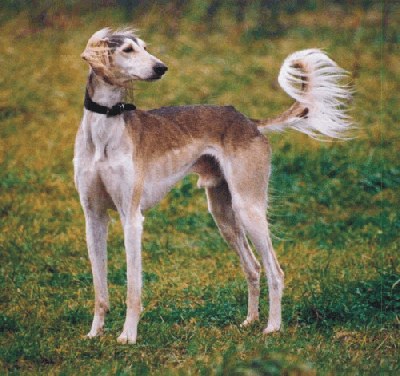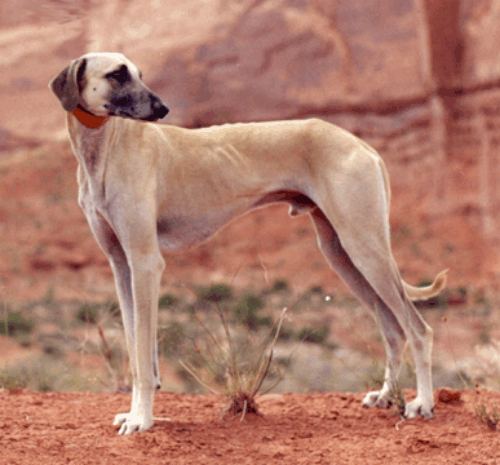| Genetics
 
Smooth coated
Weimaraner
© de Caprona ~ Long haired
Weimaraner
© Pleple2000
Ancestors of
dog breeds,
focus on the Weimaraner, comparison to other dog breeds including the
Sloughi
Summary by Dr.
Dominique
de Caprona
© de Caprona
2010
All
photographs copyrighted to the photographers. Please do not use text or
photos for any purpose without asking.
In the study
entitled "On
ancestors of dog breeds with focus on Weimaraner hunting dogs", R.
Kropatsch
and collaborators (see references) analyse the mitochondrial DNA
(mtDNA,
inherited maternally) and the Y chromosome (inherited paternally) of 27
dog breeds, with a special focus on the Weimaraner hunting dog. This
study
aims thus at understanding the sex-specific contribution at the time of
breed formation, a question which cannot be answered with the use of
autosomal
microsatellites.The Weimaraner is a German hunting pointer breed whose
first standard dates back to 1878.
A total of 111
male dogs,
34 of which were Weimaraners, were studied as well as 4 wolves from
Romania
for comparison (male dogs inherit both mtDNA and Y chromosome, whereas
female dogs inherit only the mtDNA). In all, 1947 base pairs of the
mtDNA
genome were examined, as well as 9 potentially polymorphic markers of
the
Y chromosome.
Results
20 Y chromosome and
59 mtDNA
haplotypes were identified in the 27 dog breeds and the wolves studied.
16 Y chromosome haplotypes and 55 mtDNA haplotypes were identified in
the
dog breeds.
The
Weimaraner:
in 34 male dogs of this breed of both varieties, smooth coated and
longhaired,
4 distinct Y chromosome haplotypes and 3 mtDNA haplotypes were found,
thus
showing that at least 4 different males and 3 different females awee
the
foundation of the German Weimaraner population.
Y chromosome:
Of the 4 haplotypes (Y1,Y2,Y3,Y4), the haplotypes Y1 and Y3 were found
only in the short haired Weimaraner. Haplotype Y4 is shared with the
Kuvasz
and Giant Schnauzer. The Y2 haplotype was found to be the most frequent
in the breed (50% of the dogs) and is shared with 7 other breeds
(Kuvasz,
Schapendoes, Airedale Terrier, Large Munsterlander, Miniature Poodle,
Borzoi
and Sloughi).
mtDNA:
of
the 3 mtDNA haplotypes, 2 are Weimaraner specific (M1 and M2).
Haplotype
M1 is the most frequent (67.7% of the dogs). Haplotype M2 differs from
haplotype M3 in only one position (nucleotide 8479 in the ATP synthase
subunit 6 gene). M3 is shared with the Standard Schnauzer in this
study.
This study revealed
also
some inconsistencies in the Weimaraner Studbook Some of the records
cannot
be be reconciled with these male and female founders indicating some
false
parentage at some point in time during the past 130 years of Weimaraner
breeding.
The
Weimaraner and
other pointer/hunting breeds
Comparison of
mtD-loop sequences
of the Weimaraner and the Large Münsterländer in this study
with
other breeds of pointer/hunting type dogs (German Short-Haired Pointer,
English Setter, Deutsch Drahthaar, Epagneul Breton, English Pointer,
English
Setter) in a study by Parra et al (2008) shows diverse haplotypes.
Together
25 polymorphic sites were identified, of which 14 variations in mt
D-loop
sequences were not observed in the pointer breeds of the Parra et al
study.,
and 5 variable positions detected in the pointer breeds of the
Parra
et al study were not found in the Weimaraner and the Large
Münsterländer.
The Weimaraner and the Münsterländer therefore do not share
signifant
amount of maternal lines with these other hunting breeds.
Other
breeds in the
study:
The other breeds
used for
comparison were: Australian Cattle dog, Berger des
Pyrénées,
Kuvasz, Saarlos Wolfhound, Schapendoes, Dobermann, Entlebucher Mountain
Dog, Tibetan Mastiff, Shar Pei, German Pinscher, Miniature Schnauzer,
Standard
Schnauzer, Giant Schnauzer, Airedale Terrier, Dachshund, Chow Chow,
Irish
Setter, Large Munsterlander, Weimaraner, Cocker Spaniel, Golden
Retriever,
Labrador Retriever, Miniature Poodle, Tibetan Terrier, Borzoi, Saluki, Sloughi.
Of these breeds
three asian
breeds, Sharpei, Tibetan Mastiff and Tibetan Terrier and one German
breed,
the Dobermann, are completely separated from the others in both their
mtDNA
and their Y chromosome haplotypes. All others are partially segregated
with some sharing of haplotypes with other breeds in the study.
In addition to the
breeds
above, breeds which share no maternal lines ( mtDNA haplotypes) with
others
in the study are the Kuvasz, the Saarlos Wolfhound, the Irish Setter,
the
Cocker Spaniel, the Labrador Retriever and the Sloughi and
breeds
which share no paternal lines (Y chromosome haplotypes) with others are
the Berger des Pyrénées and the Saluki.
The results of
this study
also show that this sharing of haplotypes is found across FCI groups
among
very different looking breeds, they are not restricted to within FCI
groups,
therefore not supporting the classification of these breeds in the FCI
groups.
The
Sighthounds: Borzoi,
Saluki, Sloughi
This study reveals
that
the three breeds examined are different in their maternal and paternal
lines.
  
Borzoi © de
Caprona ~ Saluki ©
Failer ~
Sloughi © de Caprona
The Borzoi
has 2 mtDNA
haplotypes, M15 being breed specific, M6 being shared with Entlebucher
Mountain Dog and Dachshund, and one Y chromosome haplotype Y2
The Saluki has
2
mtDNA
haplotypes,
haplotype
M40
being breed specific, M5 being shared
with
Golden Retriever and Berger des Pyrénées, and one breed
specific
Y chromosome haplotype Y7
The Sloughi
has
3 mtDNA haplotypes, M48, M49, M50, all breed specific and
has one Y chromosome haplotype Y2 shared with other breeds
In this study,
there is
no overlap in the mtDNA haplotypes of these 3 breeds, and
there
is no overlap between Sloughi and Saluki in both the maternal (mtDNA)
and
the paternal (Y chromosome) lineages
The Y chromosome
haplotype
Y2, shared by Borzoi and Sloughi is the most frequent in this study,
found
in very different looking breeds, and for this reason is considered to
be the most ancient, potentially in existence before breeds of dogs
differentiated
and evolved to become what they are today.
Although the number
of samples
is limited, these results add to what is already known about the
genetics
of these Sighthound breeds.
The wolves:
All the 4
mtDNA haplotypes
and the 2 Y chromosome haplotypes were wolf specific, none were shared
with the dog breeds in this study. All
4 wolves samples came from a Romanian population, with perhaps little
outcrossing
to local dogs. The authors suggest their finding is supported by other
studies of wolf populations from Eastern Europe which display spatial
genetic
structure (Pilot et al. 2006) and geographic haplotype specificity in
wolves
in other areas (Vila et al 1997).
Conclusion
The results of this
study
show that both mtDNA and Y chromosome haplotypes were shared across
breeds,
suggesting common ancient ancestry in both maternal and paternal lines.
At the same time a large number of these haplotypes were breed specific.
Regarding the
paternal lines
(Y chromosome), the authors state: "In the case of haplotype Y2
being
the most ancient and additionally the most frequent haplotype in
several
breeds, this finding could be taken as a hint that dogs generally share
a common Y chromosome pool as it was identified for mt genome (Pang
et al 2009)"
Acknowledgments
I thank
J.T. Epplen for fine tuning this text and all the photographers who
permitted the use of their photographs.
References
Kropatsch
R.,
Streitberger
K.,
Schulte-Middelmann
T.,
Dekomien G. and Epplen J.T. (2010): "On
ancestors of dog breeds with focus on Weimaraner hunting dogs", Journal
of Animal Breeding and Genetics, Blackwell Verlag GmbH, Germany.
ABOUT
THE AUTHOR
|

